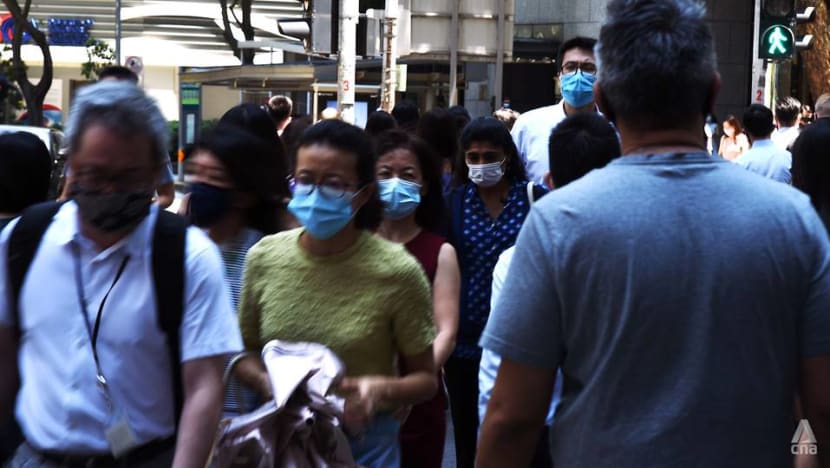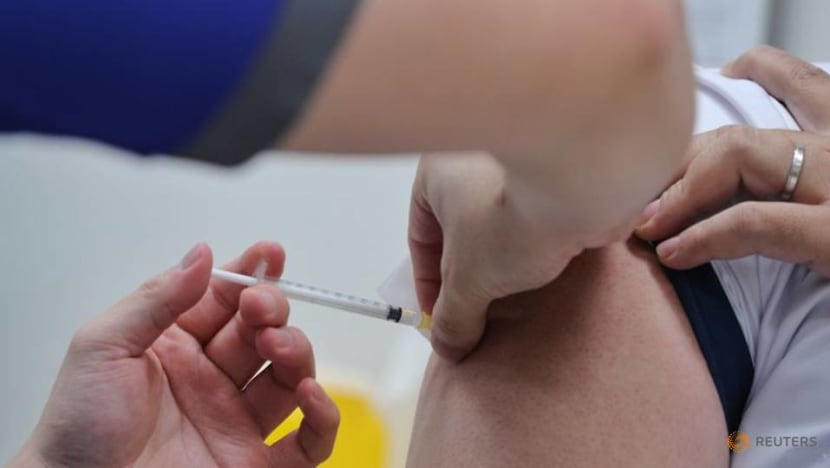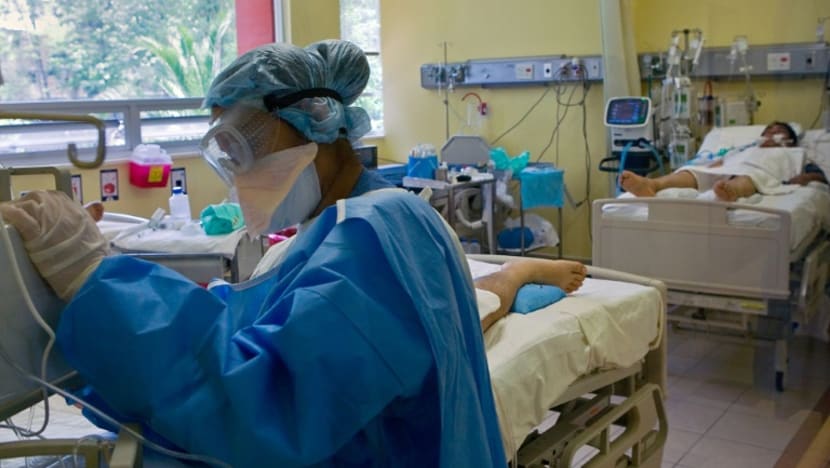commentary Commentary
Commentary: COVID-19 unlikely to become a thing of the past anytime soon
More mutations of the virus can be expected if large outbreaks continue and much depends on vaccination rates and whether more effective treatments can be developed, say Duke-NUS Medical School researchers.

Pedestrians wearing protective face masks along Singapore's Central Business District. (File Photo: Calvin Oh)
SINGAPORE: The first known case of COVID-19 occurred well over a year ago.
Countries around the world, including Singapore, then rolled out a suite of measures aimed at controlling the spread of the virus.
There have been extraordinary efforts to bring safe and effective vaccines to market in record time. Countries, including Singapore, are making concrete progress with their vaccination plans.
To date more than 850,000 individuals in Singapore and 235 million worldwide are now fully vaccinated.
Despite these big strides in fighting the pandemic, new SARS-CoV-2 infections worldwide have remained at an all-time high for the past week, at highs surpassing last year’s record.
READ: Commentary: Worries over rising COVID-19 cases are fuelling racially charged comments
READ: Commentary: Grief from losing loved ones to COVID-19 will spill into workplaces
The pendulum may now be swinging to the other side.
In Singapore, less than one month after the latest easing of COVID-19 restrictions on returning to workplaces and the resumption of larger activities, we saw new COVID-19 clusters emerge, which prompted the Government to tighten its safety measures rapidly.
There is some relief here when just two community cases were detected on Thursday (May 6).
Still, these developments raise several uncomfortable but real questions we will be forced to address, not the least of which is: Will life ever get back to the pre-COVID-19 normal or will we have to settle for a “new normal” for a much longer period?
PRECAUTIONARY MEASURES SHOULD STAY FOR LONGER PERIOD
We are inclined to suggest the latter despite the increasing availability of several COVID-19 vaccines and successful efforts to contain the spread of the virus in Singapore, Israel and other parts of the world.

There is a general misperception that the circuit breaker, continued social distancing policies, travel restrictions and contact tracing are meant to prevent the spread of the virus. That is not the case.
What they are meant to do is to slow the spread of the virus until either a safe and effective vaccine becomes available or when governments decide that the benefits of these policies are no longer worth the costs.
Simply put, these are stop-gap measures meant to buy time until better options become available.
READ: Commentary: The systematic testing Singapore needs to ditch circuit breakers for good
READ: Commentary: Why Singapore’s travel restrictions will keep changing for a while more
In other words, as soon as these policies are lifted, short of herd immunity, the number of cases and deaths are expected to once again rise.
As is currently occurring in India and was the case in China, US, Italy and elsewhere in the initial stages of the outbreak, local healthcare systems were simply overwhelmed trying to treat COVID-19 cases.
The end result was a high, but otherwise largely avoidable, mortality rate among the infected population.
Even when the world was far less interconnected, the Spanish Flu of 1918 to 1919 had three major waves that killed roughly 40 million people. As horrible as COVID-19 has been, the death toll is at over 3 million, suggesting that it could be much worse without precautionary measures in place.
This possibility is the main reason why Singapore acted swiftly to step up COVID-19 measures in view of the rising cases of community infections, and is unlikely to lift current restrictions without some certainty that it can contain future outbreaks.
(Are COVID-19 vaccines still effective against new variants? And could these increase the risk of reinfection? Experts explain why COVID-19 could become a “chronic problem" on CNA's Heart of the Matter podcast.)
WHY WE ARE FAR FROM A PRE-COVID-19 NORMAL
With the vaccination programme underway, many hope that high rates of vaccination will allow Singapore to reach herd immunity so that life can get back to the pre-COVID-19 normal. We are sceptical for at least four reasons.
First, without a mandate or additional policies that strongly encourage vaccine uptake, it is unlikely that uptake rates will be high enough to reach herd immunity levels anytime soon.
The current vaccine uptake is less than 25 per cent of the population based on the Ministry of Health’s reported 1.36 million people having received their first dose.
There is a long way to go to reach the 60 to 70 per cent rates required for herd immunity, not to mention that some population groups, including pregnant women and children under the age of 16, are not part of the vaccination programme at this moment.
READ: Commentary: My harrowing brush with COVID-19 in New Delhi as India is ravaged
READ: Commentary: Without a vaccine, how can pregnant mothers protect themselves against COVID-19?
Second, even if Singapore does reach herd immunity, the rest of the world will not. Given that vaccines are not 100 per cent effective, Singaporeans will always be at risk when people travel into the country or when they travel abroad.
For example, it is believed that the new variant that originated in India led to Singapore’s recent surge of community cases.
Third, and not unrelated, unlike what we were initially led to believe, vaccine makers Pfizer and Moderna have now acknowledged that vaccinated individuals will likely need booster shots within a year of their second jab because immunity wears off over time.
This is certainly challenging given that the world has yet to produce enough vaccines for everyone.

Fourth, as with all viruses, the virus has been mutating. There are now many known variants of concern that could lead to more severe disease symptoms and variants of interest that could be more transmissible. Mutations are expected to continue, if large outbreaks persist.
These suggest that, as with influenza, some form of COVID-19 may continue to circulate in the community for the foreseeable future.
Moreover, it remains unclear how well the current vaccines work against the variants. Evidence suggests that some of the current vaccines continue to protect against severe infection from these variant strains, but do not provide full immunity.
Greater immunity would, therefore, be required from new vaccines that target these variants directly.
READ: Commentary: Why many under 45 are hoping vaccination slots open in June
READ: Commentary: Wear your mask properly! Uncovering the reasons behind public mask shaming
MUCH DEPENDS ON IMPROVEMENTS IN PREVENTION AND TREATMENT
Our best guess for what can help us regain some sense of normalcy depends on whether improvements in prevention and treatment can make SARS-CoV-2 look more like influenza in terms of rates of infection, morbidity and mortality.
According to data from the World Health Organisation, 5 per cent to 15 per cent of the world’s population contracts an influenza virus each year, with 3 million to 5 million severe cases, and up to 650,000 deaths.
As with COVID-19, deaths most commonly occur in high-risk groups, including the elderly and people with chronic health conditions.
These statistics reveal that influenza is by no means a trivial condition, but we have accepted these outcomes as part of life. The flu vaccine is available but only with modest subsidies and few other policies in place to control its spread.
There is a possibility that COVID-19 could fade and become another flu bug in the future, as we saw in the trajectory in the H1N1 influenza outbreak, but as a far more contagious and deadlier strain.

With time, the hope is that we will eventually improve our ability to prevent and treat the virus and reduce morbidity and mortality rates to be comparable with that of influenza, if not lower.
For example, pharmaceutical giants including Pfizer, Roche and AstraZeneca, are testing antivirals in pill form, offering hope of home-use treatment options.
Until such time when vaccine uptake increases to enable herd immunity and treatment improves to lower morbidity and mortality rates, we will have to accept social distancing measures, mask wearing, contact tracing, and travel restrictions to avoid straining the local healthcare systems.
This also means that COVID-19 will unlikely be a thing of the past in near future.
Quite the contrary. We must learn to embrace the new normal and do our part to help this terrible pandemic come to an end as quickly as possible.
BOOKMARK THIS: Our comprehensive coverage of the coronavirus outbreak and its developments
Download our app or subscribe to our Telegram channel for the latest updates on the coronavirus outbreak: https://cna.asia/telegram
Professor Eric Finkelstein and Drishti Baid are researchers with the Lien Centre for Palliative Care at Duke-NUS Medical School, Singapore. Prof Finkelstein is the Centre’s Executive Director.














